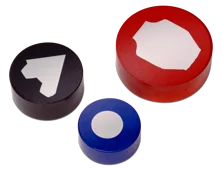Bakelite, Lucite, epoxy, or acrylic? Hot or cold? Compression or castable? With all of the options available for mounting materials, it can be difficult to know which one is the best option for your sample or why it even matters. However, your choice of mounting material is important, and it can affect the final quality of your prepared sample.
What is a mount? Why should you even mount your sample at all?
A mount is a created object used to hold a sample, usually as a thick, flat disc of a uniform shape and size. It is created by embedding the sample in question in a mounting material, which is then cured appropriately to harden around it. The mount is then ground and polished allowing the user to conduct metallographic analysis and/or hardness testing.
These analysis techniques are precisely the reason why you would mount a sample. Very few metallographic samples are in clean, easy-to-handle shapes and sizes. By mounting samples, you can turn a specimen that is small, brittle, delicate, and/or oddly shaped into something that can be used in automatic grinding and polishing machines. Mounting also has the added benefit of maintaining the integrity of a sample’s edges, as it adds extra material to support the edges and allow precise and accurate analysis of material surfaces and edges.
The wide array of mounting materials can seem daunting at first, but they can be easily separated into two main categories: cold (or castable) mounting and hot (or compression) mounting. Cold mounting involves putting the sample in a mold and filling it with the mounting material (in liquid form) and a catalyst that causes the material to cure and harden. While this process gives off heat, it usually starts at room temperature and does not reach the same temperature or pressure as hot mounting. Material used in hot mounting usually starts as a powder which is poured around a specimen in a mounting press, such as LECO’s MX-series. High temperatures and pressures are applied to cure the powder into a solid.
| Cold / Castable | Hot / Compression | |
| Specialized Instrument Needed? | No | Yes |
| Throughput? | Best for small throughput but high quantities | Best for high throughput of low quantities |
| Sample types? | Necessary for porous, brittle, or heat-sensitive samples | Best for non-sensitive samples |
| Size / Shape? | Any size, any shape mount possible | Steady stream of consistent, standard samples |
If you don’t have a mounting press, cold mounting is the only option. If you do have access to a mounting press, you can narrow your choice of mounting material based on other qualities. Abrasion rates are one key factor in choosing your mounting material. Your ideal mounting material will have a similar abrasion rate, or rate at which material is ground or polished away, to the material of your sample. It is important to note that abrasion rate is not the same as sample hardness.
Abrasion rates alone do not determine a perfect mounting material choice. The amount a material will contract or retain its edge with the sample can be a vital characteristic in your choice. Materials such as diallyl phthalate or epoxy have better edge retention than more inexpensive materials such as Bakelite or polyester. If edge retention is not as vital for your analysis, however, the expense of the material may very well be a deciding factor. Whether or not factors such as transparency or electrical conductivity are needed can play a huge role in narrowing down your mounting material choice.
Take a look at these basic properties of some of the most popular mounting materials and use them as starting points when determining the material you will use for your next samples.
Castable Mounting Material
| Type: | Shrinkage / Edge Retention | Abrasion Rate | Notes |
| Epoxy | Excellent | Excellent | High performance, slow cure, inexpensive |
| Polyester | Fair | Excellent | Fast cure, inexpensive |
| Acrylic | Good/Excellent | Excellent | Fast cure, use pressure vessel for transparent mounts |
Compression Mounting Material
| Type | Shrinkage / Edge Retention | Abrasion Rate | Notes |
| Bakelite / Phenolic | Good | Good | Most common and most cost effective, multiple colors available |
| Epoxy | Excellent | Excellent | Used with high-hardness materials |
| Diallyl Phthalate | Excellent | Excellent | Available with copper for conductivity. Excellent with tungsten carbide |
| Lucite | Fair | Fair | Transparent (easy to see multiple samples or grind to desired depth) |
Learn more about LECO’s mounting options on our website.







